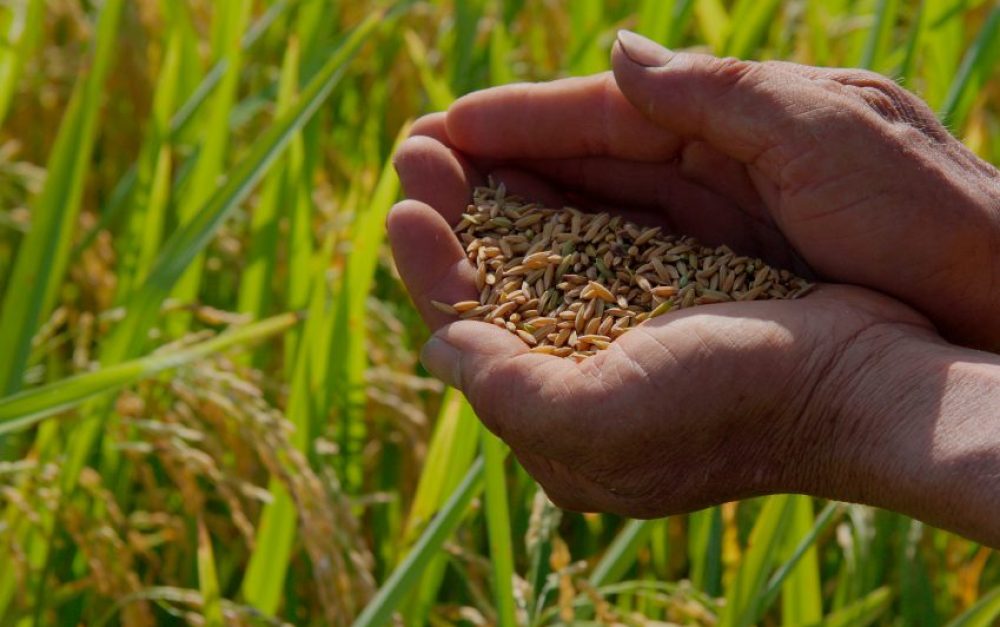Last month, a few news outlets carried a story about Filipino farmers trampling a test plot of genetically engineered (GE) “Golden Rice.” The news triggered a swift avalanche of more stories and opinion pieces, with ample space devoted to Golden Rice proponents’ harsh accusation that skeptics and critics are holding back a desperately needed, promising technology and, in so doing, are causing children’s deaths around the world.
We’ve seen all this before: both the promises that ultimately fail to deliver, and the attempts to silence those asking important questions. Why, after 30 years of research and millions of dollars poured into development of this supposed miracle seed, are we still talking about Golden Rice?
In reality, there is no new news here: Golden Rice is no closer to solving the complex societal and public health problems underlying micronutrient deficiencies than before (I’ll get into that below). We are simply getting bombarded again with the same broken promises from industry and the same prickly defensive reaction from GE scientists that play out in the mainstream media with some regularity. Having written on this topic years ago, I share Marion Nestle’s frustration with the “broken record” nature of this old argument.
But can it deliver?
Golden Rice is promoted as a technological intervention that can reduce Vitamin A Deficiency (VAD), a type of malnutrition that can cause blindness, stunting and even death. The yellow-tinted rice is touted as a way to help vulnerable populations fight VAD by delivering beta-carotene, a carotenoid which, under the right conditions, the body can convert into Vitamin A.
Can Golden Rice really accomplish this laudable goal in an efficient and effective way, or at least contribute enough to the battle against VAD to justify its expense? In considering this, it's important to get to the bottom of the following questions:
- After storing and cooking, will there be sufficient carotenoid levels left in Golden Rice to have an impact?
- How much remaining carotenoid will actually be "bioavailable" for already malnourished bodies to convert?
- And are there likely, unintended health and safety risks associated with consuming Golden Rice?
We don’t know the answers to these questions, in large part because the necessary studies have not been completed (two flawed and controversial studies notwithstanding). Or if they have been conducted, they have not been published or released for public and independent scientific scrutiny. What we do know suggests that there are still pretty significant hurdles to be overcome by the Golden Rice developers, if their product is to have any relevance.
The bigger problem with the narrow technical fixes favored by the biotech industry and lab scientists, however, is that they fail to take into account the complex underlying social, economic, political and cultural drivers of micronutrient deficiencies and malnutrition.
So far, Golden Rice has swallowed up millions of research dollars over the past two decades and filled our media outlets with hype — but has failed to deliver. This failure is particularly harmful when one considers the enormous opportunity costs of the effort: diversion of attention, precious resources and support away from the established solutions that really work.
Real solutions
Although not nearly as glitzy as Golden Rice’s high-tech, lab-based genetic manipulations, the everyday, on the ground solutions to VAD and other micronutrient deficiencies continue to make considerable headway. Significant progress in many countries has been reported by the UN Standing Committee on Nutrition, UNICEF, the World Bank, USAID and other agencies, with success attributed to the use of vitamin supplements, fortification of foodstuffs (sugar, flour, etc.) and home gardens to diversify diets and enable lasting community-based solutions. But these solid, inexpensive workhorse solutions get scant attention in the media.
There’s also a larger political context to keep in mind: farmers’ access to land, seed and water, the influence of pesticide and biotech seed companies over national agricultural research and extension, and global trade agreements that influence the price of export commodities all strongly influence the ability of a family to grow, sell and buy food. So multi-tiered efforts to address malnutrition must also be backed by sustainable and equitable trade and development policies. This in turn requires that the farmers themselves, and social movements that are demanding and creating just and viable solutions on the ground, need to be in the forefront of these debates.
The politics of story-telling
The “Golden Rice will save children’s lives (and how dare you stand in the way)” message is a particularly heated version of one that has been getting lots of play in the mainstream media these days. The insidious problem with the media’s facile uptake of this industry frame is that it silences — rather than encourages — debate. And it sets up false choices: either you swallow our technical fix, despite its failure to deliver on its promises, or you consign millions to misery and death.
Fortunately, we do not have to fall for this. We can think for ourselves and examine the story behind the story. And we can draw our own conclusions.
p.s. For an incisive dissection of how the interests of powerful industry players and philanthrocapitalists have converged in ways that continue to push narrow and inappropriate GE “solutions” to complex problems, see Sally Brooks’ pieces, here and here. For many more critiques, see the list of resources provided by GM Watch here.








